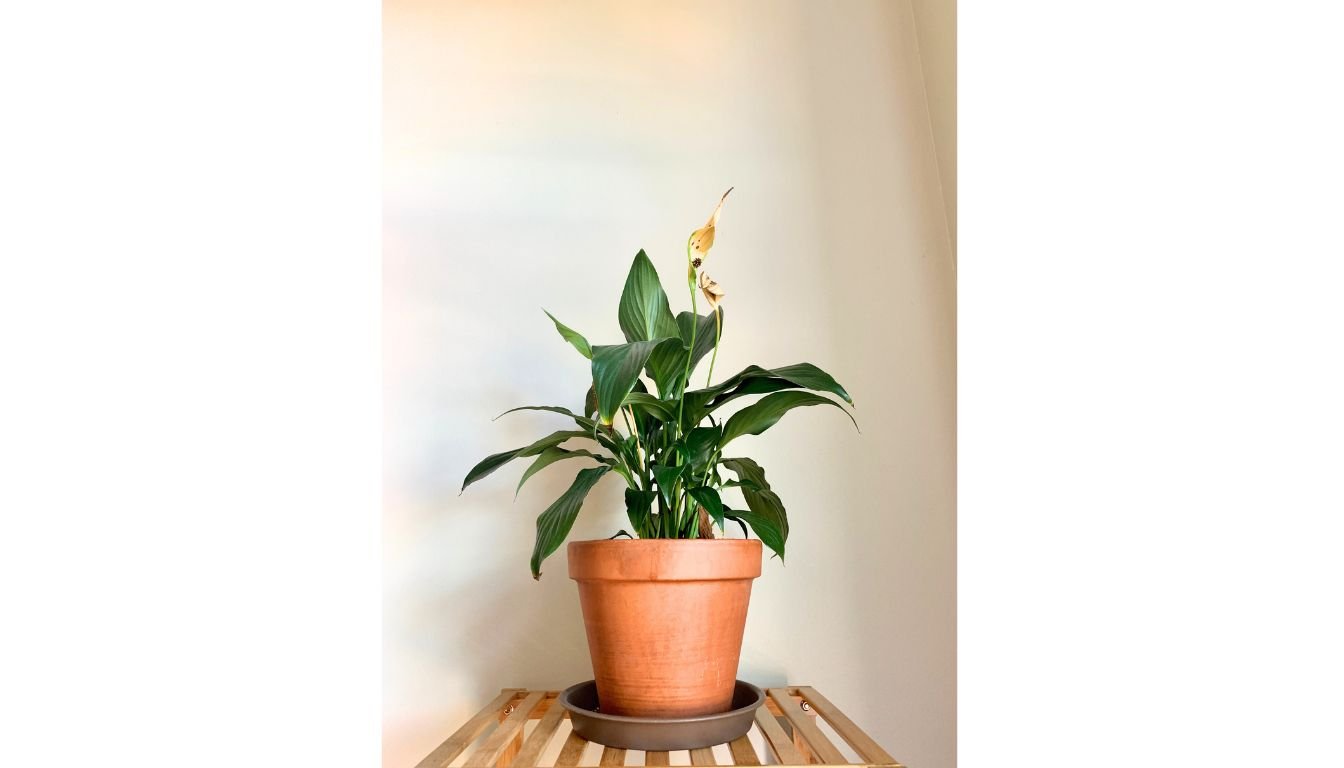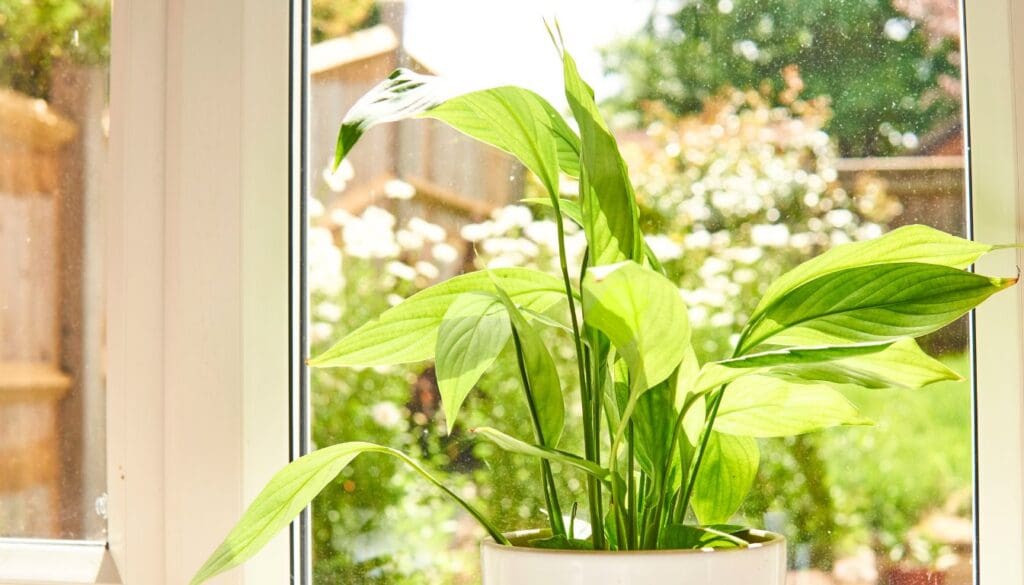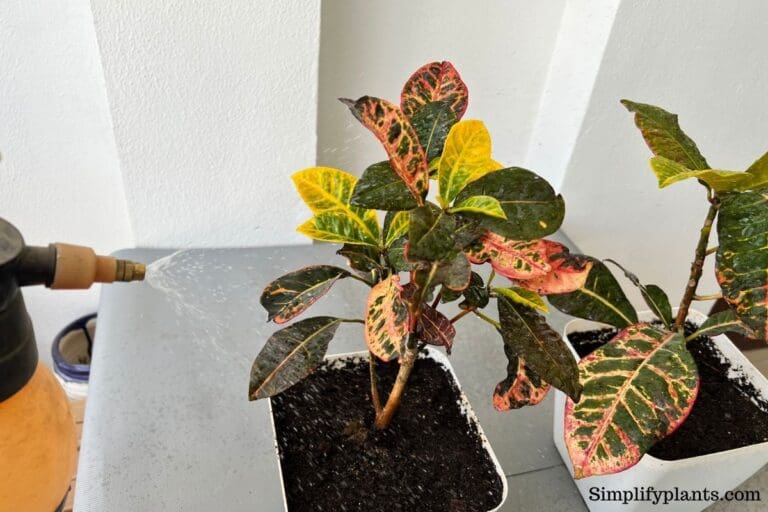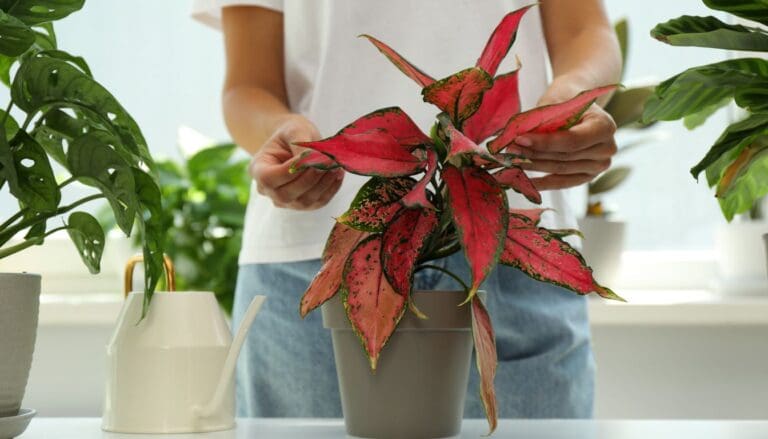How Often Does A Peace Lily Bloom? (+Ideal Blooming Conditions & More)
Peace lilies or spathiphyllum are tropical houseplants with exotic green leaves and unique white flowers. If you plan to get a peace lily plant and put its flower on display in the house, you will find yourself wondering how often does peace lilies bloom and that is what we are going to find out.
In general, peace lilies bloom twice a year-once in spring and once in fall. However, some hybrid varieties of peace lilies can rebloom. Once bloomed, the flower can last anywhere between 1-2 months. You need to provide bright indirect light and appropriate fertilizer so that the flowers can bloom.
Today we will discuss everything regarding the blooming of peace lilies, the factors that affect them, and how we can help them bloom.

Please note: Simplify Plants is reader-supported. Some links in the post are affiliate links and I get a commission from purchases made through links in the post.
Do peace lilies bloom all year?
Peace lilies have white flowers that have a unique structure. These flowers are made up of a spike that has tiny flowers around it, and this is surrounded by another structure called the spathe.
The spathe looks like a white leaf but sometimes can have a tint of green.
The peace lily flowers bloom and pollinate for ten days. After ten days, the spathe starts getting discolored and turns yellow or green. After around a month, the flowers and the spathe get dry and turn brown.
In their natural habitat, peace lilies bloom once a year. The species called Clevelandii blooms once.
But when you go to the nurseries to buy a peace lily plant, you will see blooms on them at any time. This is because of hormone treatment.
The nursery owners or florists use gibberellic acid on the peace lilies, making the peace lilies bloom within two months. So you might see that plants that haven’t reached the maturity of 12 months are also blooming in the nurseries.
We do not recommend that you use gibberellic acid on your peace lily to make it bloom, and it can have side effects that might lead to deformed leaves and flowers.
You should take care of your peace lily in natural ways and let them bloom naturally instead of forcing them to bloom throughout the year.
How often do peace lilies produce flowers?

Peace lilies can bloom twice a year if they are looked after well. You will notice the flowers in the spring and again in the fall.
However, if your peace lily blooms only once a year, do not get worried. As we mentioned in the native lands, peace lilies bloom only once a year, which is not unusual, and it might depend on the species.
You can get worried if you don’t see any bloom at all. You should help the plants bloom by providing sufficient light, water, temperature, and humidity conditions.
It would be best to prune the damaged growths and old blooms from time to time, which will allow the peace lily plant to focus its energy on new blooms.
Why is my peace lily not blooming?
Your peace lilies might not be blooming due to unfavorable conditions. If you don’t provide everything it needs, you can’t expect it to bloom.
Let’s look at the common reasons behind your peace lily not blooming.
Low light

Yes, peace lilies are great low-light plants as they can adjust to different conditions, but low light is not ideal for flower growth.
If you intend to see those beautiful white flowers on your peace lily, you need to give it enough light.
A peace lily staying in low light will maintain its foliage and look like a foliage plant, and it will not have the energy to grow flowers. Due to lack of light, the plant will lack energy for flower growth or any growth in general.
A peace lily living in a bright environment will grow faster than one living in low light.
So, the next time you wonder that your peace lily is not growing flowers, check the light and make sure it is getting enough.
Note: Provide bright indirect light to your peace lilies. Direct sunlight will be too harsh for them and can cause sunburn.
Also read: What Kind Of Light Does A Peace Lily Need? (Peace Lily Light Requirements)
Insufficient water

Water is an essential requirement that helps your peace lilies grow and stay healthy. The plants get their energy by using light and water, and nutrients.
Naturally, insufficient water supply will slow down the growth of the plant, let alone flower growth.
Many hobbyists who are unsure of how much water will be sufficient for their peace lilies give less water to avoid overwatering. This might be a reason that your peace lily is not getting enough water.
Or, if you go on a vacation and neglect the water requirements of your peace lily for a long time, it will not grow leaves of flowers and develop other problems.
So, if you are guilty of any of these or don’t see any flowers on your peace lily, it’s time to evaluate the water routine and increase the supply of the plant that is not getting enough water.
Although the water requirement of the peace lily can depend on many factors, on average, it requires watering about once a week. Since peace lilies like moist soil, you should not let the soil go bone dry and water the plant after the topsoil dries.
Also read: How Often Should A Peace Lily Be Watered? (Peace Lily Water Requirements)
Lack of nutrients

Along with sufficient light and water, nutrients in fertilizers are essential for blooms in your peace lily.
The soil often doesn’t contain enough nutrients for the plants. If you do not supply extra nutrients through fertilizers, the plant will become weak and not grow enough.
You should fertilize your peace lily plant properly during the growing season if you want to see flower growth.
Also read: What Kind Of Fertilizer Does A Peace Lily Need? (Peace Lily Fertilizer Ratio)
Soil pH
Soil pH might be another reason that is not letting your peace lily grow flowers.
If you have a soil pH test kit, you can check the soil to determine its preferable range.
Peace lilies prefer soil pH of 5.8 6.5. If the pH value is higher or lower than that, you will need to find a way to alter the pH.
Also read: What Kind Of Soil To Use For Peace Lily? (Peace Lily Soil Mix)
Temperature fluctuations

The ideal temperature requirement of peace lilies is between 68 to 85°F. The plant can tolerate slight variations but will not adjust to drastic fluctuations.
If you think your peace lily is exposed to temperature fluctuations, that might be one reason why the plant is not blooming.
This problem is more common in the winter season when it gets too cold for your peace lily, and due to the low temperature, the plant cannot bloom.
However, extremely hot conditions where your peace lily might be losing a lot of water are unfavorable for flower growth.
Therefore, you should not let your peace lily plant be subject to temperature fluctuations if you want to see flowers on it.
Old peace lily plant
This is a common reason for your peace lily plant not blooming. If you have a peace lily plant that has become quite old, the plant will fail to bloom.
You can identify an old peace lily plant by noticing the leaves. If the leaves turn yellow too fast after coming out, you have an old peace lily plant.
If your peace lily is not blooming even once a year, you might try to find out its age.
Young peace lily plant
If your peace lily plant is still young, it will not bloom. You might be wondering that when you brought it home, it had flowers, so why is it not flowering now?
This happens because nursery owners often use gibberellic acid to make the peace lilies bloom. They force the young plants to bloom so that the flowers can attract customers.
Using gibberellic acid is not a good option for the health of your peace lily. So if you are not noticing blooms in your newly bought peace lily plant, you must wait and give it time.
The plant might be a young one, so take proper care and be patient with it. You will notice blooms once the plant matures.
How do I get my peace lily to bloom again?

Now that you know the possible reasons behind your peace lily not blooming let’s check out the ideal conditions for blooming the peace lily plant.
Provide adequate light
If you want the peace lily to bloom, you cannot keep it in low light. Therefore, you must find a spot where it will get bright indirect light.
You must not expose the peace lily to direct sunlight and only provide filtered light. A window with curtains is ideal for your peace lily plant.
The idea is to mimic the natural growing environment of the plant. Peace lilies get indirect light in their native tropical rainforests.
However, if your peace lily is not growing flowers even after getting properly filtered sunlight, something else might be the problem.
Your plant might not be sitting at the right spot. Maybe it is living in a dark room or getting too much direct sunlight.
Try to find out the issue, fix it, and then give the plant some time to adjust to the new spot.
Water generously
Watering is a skill that many plant-owners take time to learn. Every plant has different water requirements, and for the peace lilies, they want the soil to remain moist and not completely dry. It would be best if you kept that in mind while watering it.
On average, you can water your peace lily once a week but make sure that the topsoil is dry.
Check that the drainage holes are not obstructed and the excess water is getting drained. Do not let the plant sit in still water.
If you want to see blooms on your peace lily, you need to water it generously but not overwater it.
Fertilize well

Since lack of nutrients can be the reason for your peace lily, not flowering, you need to provide it with proper fertilizer during the growing season.
Fertilize the peace lily with a well-balanced 20:20:20 liquid fertilizer once a month during the growing season. However, avoid fertilizing in the winter months.
Water your peace lily thoroughly after you fertilize it. This will let the fertilizer spread evenly in the soil.
If you are using granular fertilizer, be careful as an excess of it can cause root rot, root burn, or other fungal infections.
Maintain the right temperature and humidity
Peace lilies come from America’s tropical rainforests, a land with a warm temperature and a lot of humidity.
You might not provide as much warmth or moisture, but try to maintain the ideal range to promote flower growth.
Try to maintain the temperature between 68 and 85°F. Make sure that the humidity level is 50%.
During the winter season, protect your plant from cold drafts and frost. It does not prefer low temperatures so try to maintain average room temperature.
Keep the peace lily away from radiators for air conditioning vents as the dry air can reduce the humidity level for your plant.
Do you cut off dead peace lily flowers?
Yes, it would be best if you pruned the spent flowers as soon as you noticed that the flowers were turning brown or wilting. You must also remove the stalk.
This is a fantastic way to make your peace lily bloom again. Pruning the spent flowers promotes reblooming and protects the plant from pest infestation for fungal attacks.
You will notice that the flowers on your peace lily start turning brown after a month of their emergence, and you should prune these flowers if you want new ones.
Final words
Peace lilies can bloom annually or twice a year, depending on the care it is getting, the conditions it is exposed to, and the type of species you have.
Provide bright indirect light, thorough watering once a week, proper fertilization once a month during the growing season, and maintain the right temperature and humidity. You will see great blooms on your peace lily.
Refrain from using gibberellic acid and prune the spent flowers to make your peace lily rebloom.
Ref: ScienceDirect, NCBI, University of Vermont, Nationalgeographic, NC state university, University of Florida, The University of Arkansas, Queensland Government.
Recommended Garden Supplies
| Product Image | Our Recommended Gardening Supplies | Check Offers! |
|---|---|---|
Top Top
Top
Top
Top
Top
Top
Top
Top | rePotme Houseplant and Tropical Classic Potting Soil Mix | Check Offer On Amazon |
 Top
Top
Top
Top
Top
Top
Top
Top | Espoma Organic Indoor Plant Food | Check Offer On Amazon |
 Top
Top
Top
Top
Top
Top
Top
Top | GooingTop LED Grow Light 6000K Full Spectrum Clip Plant Growing Lamp | Check Offer On Amazon |
 Top
Top
Top
Top
Top
Top
Top
Top | Soil Moisture Meter | Check Offer On Amazon |
 Top
Top
Top
Top
Top
Top
Top
Top | Govee Hygrometer Thermometer, Bluetooth Enabled! | Check Offer On Amazon |
 Top
Top | LEVOIT Humidifiers for Large Room(Best For Plants) | Check Offer On Amazon |
 Top
Top
Top
Top
Top
Top
Top
Top | Upgraded DIY Automatic Drip Irrigation Kit, 15 Potted Houseplants Support | Check Offer On Amazon |
 Top
Top
Top
Top
Top
Top
Top
Top | Stainless Steel Heavy Duty Gardening Tool Set | Check Offer On Amazon |
 Top
Top
Top
Top
Top
Top
Top
Top | Bonide Insecticidal Soap | Check Offer On Amazon |
 Top
Top
Top
Top
Top
Top
Top
Top | Bonide 32 oz Spray Neem Oil for Organic Gardening | Check Offer On Amazon |
 Top
Top
Top
Top
Top
Top
Top
Top | Garden Safe Fungicide | Check Offer On Amazon |






